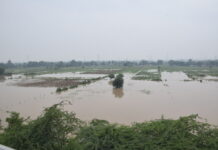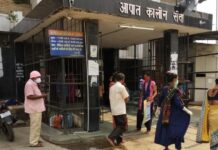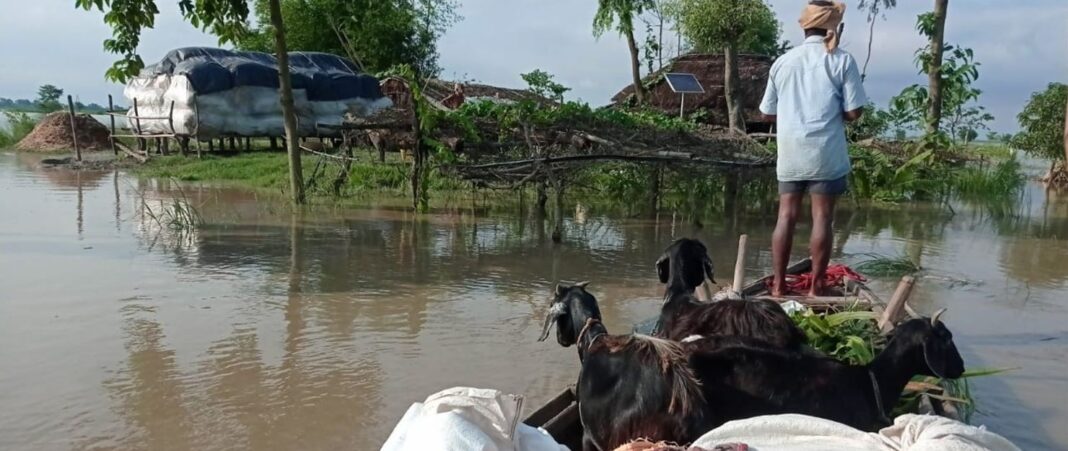As the monsoon season has set in the spectre of floods has come to haunt Bihar once again. Like previous years, this time around the state government's promises of a better flood management strategy turned out to be hollow. Water flooding villages and
agricultural fields are enough to call the government’s bluff.
According to a recent report from the Central Water Commission, the water level in many rivers of Bihar is rising rapidly, causing a severe flood situation in more than half a
dozen districts forcing people to flee for safety. Water Resources Department also reported that rivers, namely Gandak, Budhi Gandak, Bagmati, Kamla and Mahananda, were flowing above the danger mark at 15 gauge stations.
Floodwaters have already entered villages in many districts of the state. Thousands of villagers have already left their homes and hearth to take shelter at safer places. With hundreds of acres of agricultural land submerged in floodwater standing crops have been damaged beyond redemption.
Chief Minister Nitish Kumar had visited a dozen flood-affected districts of north Bihar and talked about carrying out relief operations. But surprisingly no data on the flood-affected areas has been provided on the official websites of the Bihar government.
Unprecedented rains
Speaking to this correspondent, residents of several villages submerged in the flood water lamented that the government was neither prepared for this eventuality, nor was it keen to
provide relief to the affected people in the aftermath of the floods. The government’s assurance of preparations fell flat on its face.
Ujjwal Kumar, a resident of Ramnagar block of West Champaran district, said that the crops grown on the 40 acres of farmland in his village have been destroyed by the floods. He informed the district administration about the embankment on River Masan, but no action has been initiated as yet.
Nandkishore Yadav, mukhiya (head) of Nimuia Panchayat in Gopalganj told this correspondent that the entire panchayat is waterlogged, but the administration has yet to take notice leave alone making efforts to get over the situation.
According to the Indian Meteorological Department (IMD), in June, Bihar received 140 percent more than normal rain, which is unprecedented for the state. Between June 1 and 26, the state has recorded 307 mm rain, about 25 percent of the total monsoon rainfall. Bihar usually gets 1100 mm rainfall during the monsoon.
According to the data obtained from IMD, except Rohtas, all the districts of Bihar have received more than normal rainfall since June 1. Siwan, Supaul, Darbhanga, Madhubani, Samastipur, Kaimur and West Champaran received two to threefold more rainfall than normal. In West Champaran, there should be 321.8 mm rainfall but it has received 1120.2 mm rainfall.
So far, Bihar has received 448.5 mm rainfall which is almost double the normal rainfall (253 mm). Over and above, heavy downpours in the Terai area and the forecast of heavy rains in Nepal are a matter of concern for the state. Since most of the rivers that cause floods in Bihar originate from the neighbouring country, heavy rainfall in Nepal is bound to have an adverse impact on Bihar.
The water resource department released a statement on July 3 that Burhi Gandak river at Simra station, Bagmati/Adwara river basin at Janakpur station, Kosi basin at Dharan station and Mahananda basin in Biratnagar station in Nepal received 140.5 mm, 110 mm, 130 mm and 107.9 mm rainfall respectively. This means another round of unprecedented floods are in store for Bihar.
2,300 deaths
Almost every year floods cause heavy loss to agricultural and infrastructural while disrupting normal life in Bihar. In the last decade, as many as 2,300 people have died due to flood-related incidents. In the year 2017 alone 815 lives lost floods.
During this period, crops worth Rs 2,02,517.64 lakh were damaged and Rs. 43,059.82 lakh worth public property was lost. However, no timely precautions are taken to contains the losses due to flood. The incumbent government under Chief Minister Nitish Kumar is no different in responding to floods.
The way out
Flooding is not new to Bihar. Around 76 per cent of the state’s population in northern districts lives under the threat of flood devastation. Of the 95,163 sq km geographical area of the state, roughly 68,800 sq Km is flood affected.
Around 6-7 decades ago, the floods that used to strike the state were of a different nature. Back then, floodwater would recede within 3-4 days. Villagers from Muzaffarpur and other flood-prone areas say since the floodwater used to give in within a few days, the losses were not as heavy. What’s more, the flood water would play an important role in keeping the agricultural fieldsfertile.
Centuries ago, a few kilometre long embankments were constructed while leaving large parts of the rivers unbanked to allow the rivers to flow freely. After independence, the
government undertook the task of constructing embankments on both sides of the rivers. The first major embankment work started in the late 60s on River Kosi.
Till now, 3,790 km long embankments have been built over 13 rivers in Bihar. These huge embankments which came into being ostensibly to contain the floods turned into a curse for the people over the years.
Dinesh Mishra, who has been working on Bihar rivers for four decades, said that the rivers of Bihar change their course frequently. So, binding them with embankments is anyway, not a good idea.
“Earlier when the floods would come, water used to drain out in two-and-a-half days. But now, it remains stationary for two and a half months. This is because there is no arrangement for its raining out the water entering villages and agricultural fields. There is an urgent need to make arrangements for the drainage system.”
But the irony is that the government is not paying heed to this demand. Many experts have listed the drawbacks of the embankments and called them harmful for the people. But the
government is consistently emphasising on building more and more embankments. Take the example of Muzaffarpur, people here have been protesting against the embankment on Bagmati for many years now. But the government is adamant about going ahead with the project at any cost.
Given the nature of floods and disadvantages of embankments, the need of the hour is to explore the option of various drainage systems for the flood-prone areas to ameliorate the grievances of the flood-hit.
Disclaimer: We do undertake rigorous checks on content provided by contributors before publishing the same. If you come across some factual errors, kindly bring this into our notice and we shall review your objection and claim as per our policy and display correction credits and corrections on the article itself.
The opinion expressed in the article is of the writer. Writer is a freelance journalist/journalist based in Delhi




























